The Hunt for Ankhesenamun: How Did a Young Woman Stop an Ancient Dynasty from Imploding? Part I
The names of Akhenaten, Nefertiti, and Tutankhamun—prominent players from the Eighteenth Dynasty of the New Kingdom period in ancient Egypt—have been in the spotlight for well over a century. Extensive research, documentaries, and publications have served to keep the mystique of the Amarna royals alive in our collective consciousness. However, a key figure from this family, Queen Ankhesenamun, is either ignored or given little prominence in most narratives.
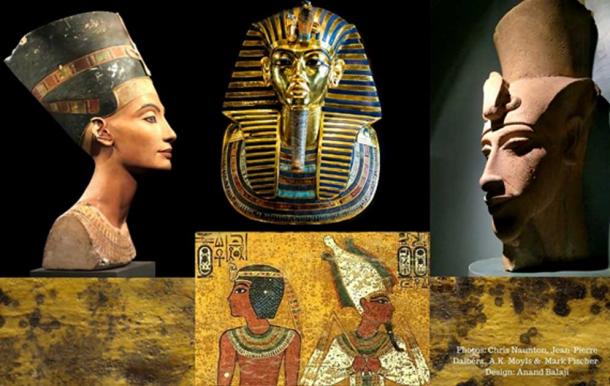
(From left) The painted bust of Queen Nefertiti (Berlin Museum/ Jean-Pierre Dalbéra/ CC BY 2.0 ); Tutankhamun’s golden mask (Cairo Museum/Mark Fisher/ CC BY-SA 2.0 ); remnants of a colossal sculpture of Akhenaten discovered at Karnak (Luxor Museum); funerary scenes on the north wall of KV62 and (Background) close-up of the ubiquitous fungoid spots in the tomb.
Flower Child of Akhetaten
Ankhesenamun is portrayed in myriad ways; as a terrified and hapless youngster; a power-hungry murderess; or a loathsome vixen who will stop at nothing to achieve her devious ends. Very few characterizations concentrate on the real person, sans the hype. But then, with irrefutable facts hard to come by, any exotic soap opera can be built around an ancient individual! This once-powerful queen surely deserves a far better study of her personage; for she seems to have managed to prevent a dynasty from imploding—and that is her lasting legacy.
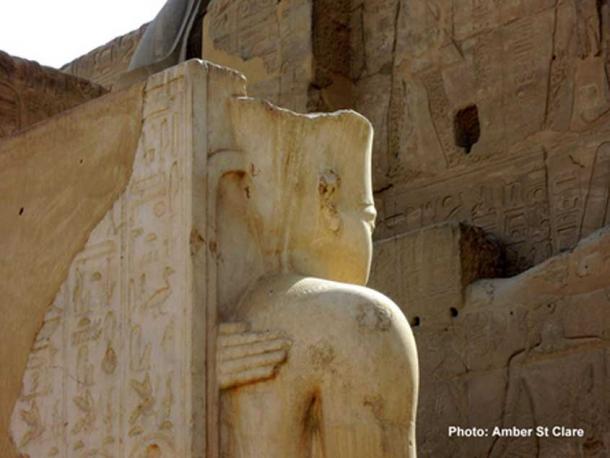
The hand of Ankhesenamun rests protectively upon the back of her husband and half-brother Pharaoh Tutankhamun, in this statue at Karnak Temple. The penultimate ruler of the Eighteenth Dynasty, King Aye, probably married the young queen to legitimize his claim to the throne.
Born Ankhesenpaaten in Regnal Year 5 or 6 of the enigmatic Pharaoh Neferkheperure-waenre Akhenaten, this girl would ensure that her family consolidated their hold on the throne against tremendous odds. The third of six daughters of the Heretic and his enchanting wife, Nefertiti; she was probably born in the new capital Akhetaten―‘Horizon of the Aten’ (modern Tell el-Amarna).
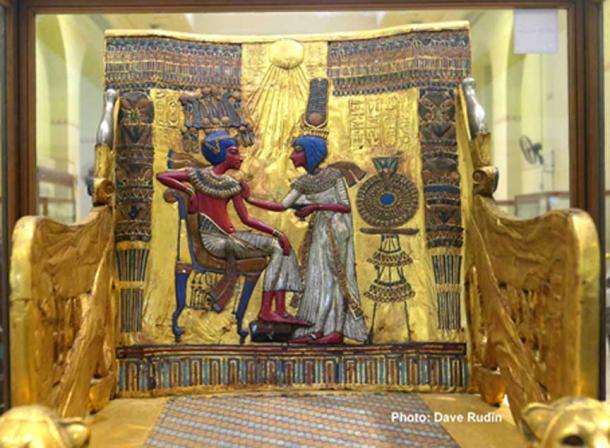
This much-altered ornate Golden Throne, an Amarna era relic, shows Tutankhamun and Ankhesenamun under the rays of the Aten sun disc. Howard Carter said it was “the most beautiful thing that has ever been found in Egypt”. The object bears the name of the boy-king in the earlier Aten form (Tutankhaten) on the right outer arm. Egyptian Museum, Cairo.
Ankhesenpaaten was raised in an opulent, but heavily-guarded environment; for in his overweening idealism, her father had dared to annul centuries-old religious beliefs by discarding the pantheon of deities, especially the state god Amun, and proclaimed that there was but one divinity, the Aten―the radiant solar disc. One of the references to Ankhesenpaaten found on Amarna monuments reads King’s daughter of his Body, his beloved Ankhes-en-pa-aten, born of the great royal wife, his beloved, Lady of the Two Lands (Neferneferuaten Nefertiti) . The idyllic, paradisiacal life that the art of that age depicted seems to have been a conscious effort to herald the glories of the monotheistic experiment at Amarna. In reality, however, it was but an astute facade for the terrible inner tumult; and matters would soon plummet inexorably.
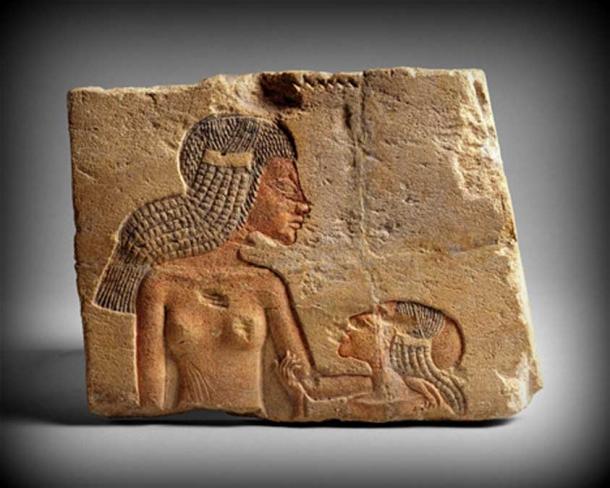
The demonstration of affection in this detail showing two of Akhenaten’s daughters – probably Meritaten and Ankhesenamun – is typical of the intimacy allowed in representations of the royal family during the Amarna period. Metropolitan Museum of Art, New York. ( Public Domain )
Calamity and Queens
Not long after the dazzling Durbar in Year 12 of Akhenaten’s reign, a tragedy of immense proportions struck Akhetaten. Scenes in the communal royal tomb in the eastern desert cliffs of Amarna (TA26) reveal grim evidence of several burials having taken place. Archaeologists attribute it to a plague that swept the city, which consumed scores of citizens in its wake. The Queen-Mother Tiye also passed away at about this time and was buried in the principal burial chamber of the sepulcher. Princess Meketaten, the royal couple’s second daughter too followed her grandmother in death.
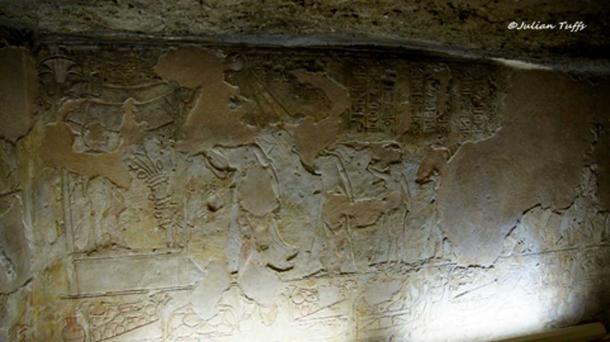
The famous “mourning scene” in the communal Royal Tomb at Amarna (TA 26B – Chamber gamma) shows Akhenaten and Nefertiti grieving the death of Princess Meketaten. This is an incomparable representation—not seen before or since in Egyptian art—involving a Pharaoh and his family. In a register nearby, a nurse cradles a baby, thought to be Tutankhaten.
While these events must have caused Akhenaten great sorrow; sadder still he must have been over his inability to produce a male heir to inherit the throne. To ensure the continuation of his religious policy the king elevated Nefertiti to the status of co-regent. Though not Akhenaten’s sister, as recent DNA results of Tutankhamun’s parentage suggest, it is widely believed that a minor wife Kiya, who bore a unique title “hemet mererty aat” meaning “Greatly Beloved Wife” provided the Heretic with a male heir—the Horus-in-the-Nest he yearned for—in the person of Tutankhaten. She disappeared from the records in Regnal Year 11.
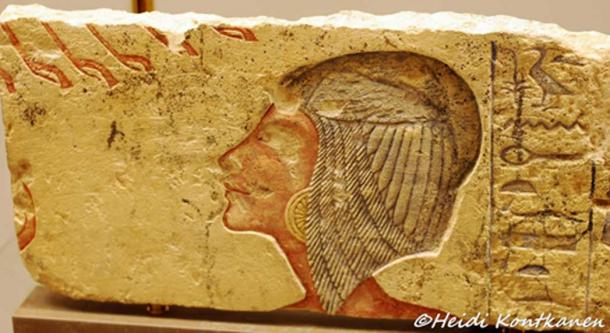
This painted limestone relief originally depicted Kiya, Akhenaten’s ‘Greatly Beloved Wife’ but was later reworked to portray Meritaten his daughter. The splendid North Palace at Amarna was dedicated to this obscure wife. Ny Carlsberg Glyptotek, Copenhagen.
Later, in Regnal Year 17 the monarch himself died and this created a power vacuum which young Tutankhaten could not fill immediately because his legitimate ascent was blocked by powerful individuals. This is where matters become hazy for Egyptologists.
Up until the discovery of the Deir El-Bersha quarry graffito, it was believed that Nefertiti had either died or had fallen from grace in or around Akhenaten’s Regnal Year 12 (her latest attested date). But the graffito proved that she was still around in Year 16 as a queen. Did Nefertiti rule as sole pharaoh by changing her name to Ankhkheperure Smenkhkare-Djeserkheperu? After all, she is depicted wearing regalia of high office and performing pharaonic duties, even while her husband was alive.

A fragment of a limestone column from the Great Palace at Amarna depicts Nefertiti and her eldest daughter Meritaten adoring the Aten. The Queen wears the twin feathers of Shu and the ram’s horns upon her head. It is possible that Meritaten followed in her mother’s footsteps to become pharaoh. Ashmolean Museum, Oxford.
Moreover, opinion remains divided on whether a female pharaoh, Ankh(et)kheperure Neferneferuaten, who seems to have held the reins of power in the interregnum between Akhenaten’s death and young Tutankhaten ascending the throne, tried to make peace with the Amun priesthood.

The controversial, unfinished stele dedicated by Pasi/Pay shows two Amarna kings in an affectionate pose—long thought to depict Akhenaten and Nefertiti in her “quasi-kingly” status, wearing the double crown of Egypt. Neues Museum, Berlin.
The famous Pawah graffito (TT139) dated to Regnal Year 3 of Neferneferuaten was written by a “lay-priest and scribe of god’s offerings of Amun in the temple of Ankhkheperure in Thebes.” The existence of offerings to Amun in this structure, perhaps her mortuary temple, has long been seen as proof that her reign extended for a time beyond that of Akhenaten, in whose final years Amun had been proscribed. Nefertiti (or Meritaten) seems to have tried to find a middle path between the old polytheistic system and the new monotheistic one.
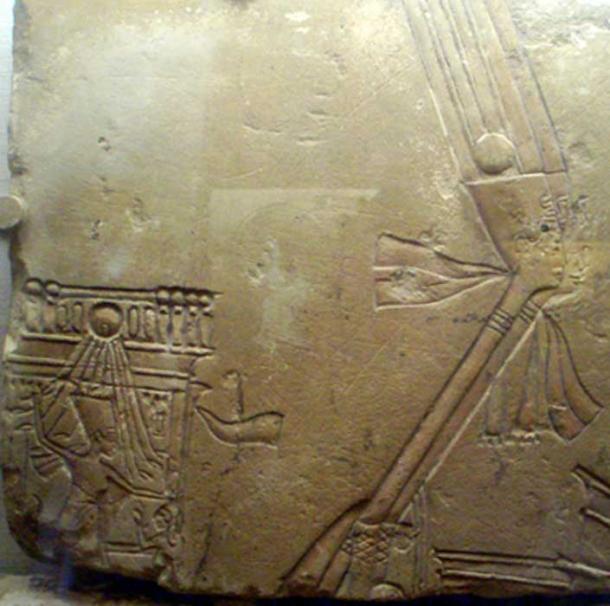
A close-up of a limestone relief shows an extraordinary representation of Queen Nefertiti smiting a female captive on a royal barge—a time-honored depiction, solely reserved for ruling kings. Museum of Fine Arts, Boston. (Photo: Captmondo/ CC BY-SA 3.0 )
But this shadowy figure did not last very long, and Egypt was once more plunged into darkness. Enter Ankhesenpaaten, the last surviving daughter of Akhenaten; the only beacon of hope for the dynasty. As a child of twelve or thirteen, she married her half-brother and new ruler, Nebkheperure Tutankhaten Hekaiunushema, a nine-year-old.
And so the child-wife Ankhesenpaaten entered her first marriage which would maintain her family’s position of power a while longer.
In Part II, we continue to follow the life of Ankhesenpaaten as she adopts the more orthodox name Ankhesenamun; loses her childhood companion and marries her grand-uncle (or grandfather) to continue her rule as queen.
Related Post
A shocking documentary proves that mermaids do exist
SHOCKING Revelation: Thuya, Mother of Queen Tiye, Was the Grandmother of Akhenaten and Tutankhamun—What Ancient Egyptian Secrets Did She Leave Behind?
Breaking News: Astonishing Discoveries at Karahan Tepe Confirm an Extraterrestrial Civilization is Hiding on Earth, and NO ONE Knows!
Breaking News: Researchers FINALLY Discover U.S. Navy Flight 19 After 75 Years Lost in the Bermuda Triangle!
NASA’s Secret Investigation: Uncovering the Astonishing Mystery of the UFO Crash on the Mountain!
Explosive UFO Docs LEAKED: Startling Proof That Aliens Ruled Ancient Egypt!